Little London PFI scandal - how Leeds City Council blackmailed a community
Bifo | 10.03.2006 20:47 | Free Spaces | Social Struggles
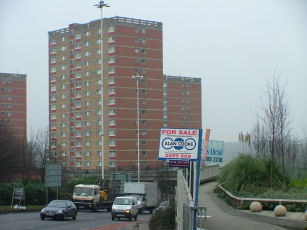
Parts of Little London will now be sold off under the PFI scheme

Mark Harris, Joint Leader of the Council, hates PFI but says "there's no choice"
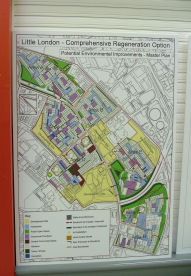
The Council only showed plans for the PFI scheme, not Decent Homes
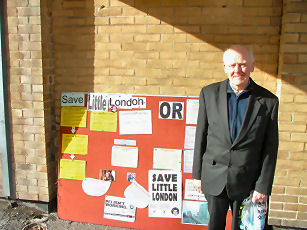
Lloyd, a tenant of 40 years, stands proudly with the "counter exhibition"
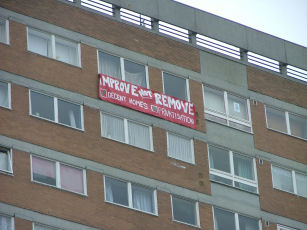
Tenant's opposition is building - dozens of similar banners have been requested
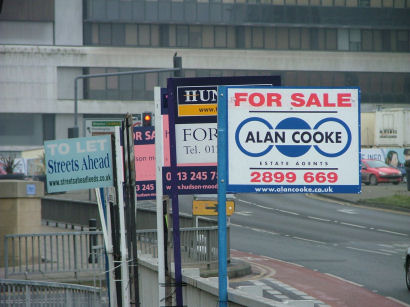
This is the future of Little London - but who can afford to live in them?
In March 2002, after decades of neglect and disrepair, tenants and residents of Woodhouse and Little London area of Leeds were balloted by Leeds City Council on whether they wanted a £35m Private Finance Initiative (PFI) to regenerate council housing in their area. The Council did so as part of the government's flagship "Pathfinder" scheme, which was first unveiled in 1998 by the Office of Deputy Prime Minister (ODPM) John Prescott and involves using PFI - money lent to developers up front by private banks - to finance council house regeneration. To clarify, PFI does not involve "stock transfer" of council property, which effectively means privatisation. Instead, the council retains ownership of the social housing. Stock transfer of council housing usually involves it being sold off to competitive housing market or to a so-called social landlord like a Housing Association. Eight councils across England were selected to test PFI as a way of refurbishing council homes, one being Leeds. Since then, the Pathfinder process has been in deep trouble and dogged by delays. Leeds City Council has proven particularly troublesome for the government.
In 1999, Leeds Council published its first plans to deploy the government’s PFI regeneration scheme for the Swarcliffe estate. There was little consultation and tenants and residents were not balloted. The council then put a stop on letting in the area, emptying properties one by one and then bulldozing them for developers at the taxpayers’ expense. But after contractual wrangling with both the government and private companies, there would be a shocking delay of six years before any building work actually began.
Just as the Swarcliffe debacle was kicking off, in 2000, the Council began hosting a series of public meetings with tenants and residents of Little London and Woodhouse area in Leeds about regeneration plans for their council estates. Predictably, the proposed £35m PFI regeneration scheme came with a number of catches, namely that some council land and housing would be sold off for developers to turn into private flats or homes so as to make the PFI lucrative for the private sector. The plan involved removing around a quarter of council homes (and the people living in them) by leasing off one each of the Lovell and Oatland tower blocks to a private developer, demolishing two tower blocks (the Carlton Towers) and a row of maisonettes in order to then allow a developer to build so-called "affordable social housing" for sale.
The Council called it a "once in a lifetime offer". However, much to everyone’s surprise, thanks to a strong campaign by tenants and the trade union Unison, when it came to the ballot, 54% of voting residents in Little London and Woodhouse said NO to the proposed PFI-regeneration on a whopping 67% turnout – compare this to appalling 26.9% turnout for the Hyde Park and Woodhouse ward in the 2004 council elections. Opposition to PFI was based on widespread understanding that the Council was attempting to "gentrify" the area – that is, change the nature and ownership of some of the housing stock and land in order to attract richer people in and kick poorer people out. Little London estate was particularly lucrative because it stood right on the City Centre boundary and was prime building land. Reducing the amount of council housing and increasing the amount of so-called affordable and private homes would enable middle class city workers to move in, and allow developers to make a small fortune from being able to charge the hyper-inflated city rates for flats and houses.
Having said NO, tenants thought this was the end of the matter and lobbied the Council to start making the repairs to their properties that had been deliberately put off by housing managers in anticipation of the PFI going through. For Leeds City Council, however, this was the "wrong result" and they immediately set about correcting it. For them, PFI was the only show in town and as this was a Labour-run council and part of the government's Pathfinder scheme, they had to make it work. Using a detailed breakdown of the results across the area, they were able to determine that there was a majority in favour of PFI within the Little London area by itself. Magically, within weeks they had devised a new regeneration proposal just for Little London and with Woodhouse residents now removed, re-balloted council tenants in the former area and got the YES vote they were after. However, almost half of tenants eligible to vote did not do so (46%), giving the PFI scheme no serious democratic mandate.
Unsurprisingly, no councillors spoke out against this shocking abuse of democracy, except the charismatic Lib Dem councillor, Mark Harris. Although publicly opposed to PFI as a financing tool, he reluctantly accepted there was "no alternative" for regeneration. But he was also adamant that the "sanctity of the ballot" should be respected and criticised the then Labour Council for "asking until they got the right answer". At a public meeting with tenants and residents on 2 February, Harris, now Joint Council Leader as part of the ruling coalition involving Tories, Lib Dems and Greens elected in 2004, reiterated his original feelings:
"That original ballot was a complete put up job…you should never hold a ballot if you are not prepared to accept the result of the ballot and that is exactly what happened. A ballot was held, the ‘wrong answer’ was given."
Significantly, Little London and Woodhouse Tenants and Residents Association, which had represented the tenants in meetings with the Council and played a large part in agreeing the nature of the consultation, released a public statement criticising the council’s decision not to respect the ballot.
"We, the members of the Steering Committee PPFI Little London and Woodhouse, would like to register our disappointment and anger that the result of the Ballot is not being accepted by the Council as the wishes of the tenants of the area"
Their pleas fell on deaf ears, however, and after hailing the vote as proof that Little London wanted to "modernise", the Council then did a "Swarcliffe" – it went missing for three and a half years. There was virtually no communication about when the redevelopment would begin. Information was then leaked that the reason for the delay was that tha government had put a block on the Little London PFI scheme until Leeds City Council got Swarcliffe underway and "learned the lessons of its past mistakes" – the Office of the Deputy Prime Minister did not want the risk of allowing Leeds two PFI schemes until had it proven itself capable of delivering one.
The only thing that happened was another ballot in 2004, this time to transfer the day to day running of council housing to an Arms Length Management Organisation (ALMO) wholly owned by the Council, Leeds North West Homes. This process was repeated across the city, creating six ALMOs in total (see umbrella body Leeds Homes). Throughout this time, virtually no major repairs were carried out in the Little London as the ALMO had not been given a full capital budget in anticipation of the PFI rebuild starting.
Two major changes to tenancies, however, were introduced. The first was the replacement of most long-term leases with one-year contracts, bringing council tenants in line with the private renting market and giving the Council far more power to remove people from the area when necessary. The second change was the growing number of asylum seekers who were being deliberately moved by the National Asylum Support Service (NASS) into council flats while waiting for their claims to be processed. This made the nature of people in Little London far more transient, increasing the turnover of tenants and weakening people’s bonds to the area.
Finally, in May 2005, with Swarcliffe PFI contract now signed, the Council were allowed to proceed with Little London PFI regeneration. However, because of the three and half year delay, not only had a large percentage of tenancies had changed hands in Little London but government policy had also evolved to the point whereby tenants did now theoretically have a choice between a a major PFI scheme or a more modest repair process to get all council homes up to the government's minimum Decency standard by 2010. The government thus directed the Council to arrange a fresh consultation exercise in order to get a new mandate for PFI, and subsequently Little London Tenants and Residents Association were invited to take part in ‘scoping meeting’ in May to start taking the stalled regeneration forward.
Between June to September 2005, a general consultation of residents took place, including a sample door-to-door survey of 150 homes, a postal questionnaire of every home and an Open Day. The aim was to find out what residents thought about Little London and their views on improvements needed to the estate’s housing, environment and management. Unsurprisingly, the survey showed that almost all Little London residents liked living there, were happy with the size of their houses or flats and just wanted promised repairs, improvements and better management of their housing.
Then in February of this year, after months of meetings between Councillors, Council officers, the ALMO, Little London Tenants and Residents Association, community workers and Banks of the Wear, a consultancy firm employed by the Council as the "Independent Tenants Advisor", the Council conducted a two week door-to-door consultation of Little London's 1500 tenancies on two options for improving the area:
Option 1: Decent Homes. This would use the ALMO's £20m capped funding approved by central government to bring all Council-owned properties up to the government's promised minimum Decency Standard level by 2010. So homes that need a new kitchen, new windows, new bathroom, heating, doors and insulation would get them, there would also be communal facilities provided in blocks of flats, but there would be little or no expenditure on homes that already met the Decent Homes standard. The Decent Homes proposal clearly fell short of what tenants and the Little London area need, but it had one huge advantage in that work could start almost immediately, the vast majority council housing stock would be retained, there would be very little in way of demolitions and it was unlikely that anyone would have to leave the estate.
Option 2: Comprehensive Regeneration. This was a proposed £85m Private Finance Initiative (PFI) scheme over 30 years that would involve a fairly drastic re-design of the existing estate. 435 council homes would be demolished or sold off to private developers, with the released land and property being used to create 400 new or refurbished private homes on the estate. 300 of this new private housing would be ear-marked as "affordable", although the Council's vague estimations of "low cost" prices at between £55,000 and £110,000 was hardly reassuring. Nor were the prices "affordable". Currently, council tenants can buy their flats for as little as £6,000 and their homes for around £20,000 under the 'right to buy' policy. Only 125 new council homes would be built to replace those lost. Properties remaining in Council ownership would be improved 'above the Decency Standard' but at least 435 and as many as a 1000 people depending on family sizes would be forced to leave the estate. If they agreed to leave, they would receive £3,800 compensation plus moving costs minus any rent arrears; if they wanted to stay, they would still have to leave the estate but would receive no compensation and only the promise that "the council would do the best it could to rehouse you back in Little London when regeneration work has finished" - in short, the Council refused to guarantee that people could return to Little London. Work would not start until at least late 2008 and major rebuilding would not be completed until at least 2013 with the Council unable to guarantee an end date.
Overall, the Council was offering the tenants and residents of Little London two unsatisfactory and unfair options, either substantial investment for the majority and eviction for a minority, or an under-investment for all that would recreate the need for regeneration further down the line. Just like in 2002, councillor after councillor rose at a public meeting on 2 February at Little London Primary School to say that this was "a once in a lifetime opportunity", but that "if the people of Little London don't want the Comprehensive regeneration, they don't have to have it". The sting in the tail, however, was that in contrast to 2002, the Council was not now offering tenants a straight "ballot" in which they could actually decide. Instead, they were to be "consulted" through a survey that canvassed opinions about two non-negotiable options put forward by the council - and it would be the Council, not an independent adjudicator, that would "interpret" the results.
This consultation, which cost in excess of £2 million of taxpayers money, was supposed to present tenants with the two options in a fair and balanced way. And the Council's public rhetoric about wanting to ask residents which option they favoured for improving their estate certainly chimed with this. Yet in reality, this illusion of choice was a complete fraud: the Council, councillors and the ALMO had already decided that they favoured the Comprehensive Regeneration Option and the aim of the consultation was not to "consult" but to "convince" enough tenants that the PFI scheme was what they really wanted.
This determination to push residents down the PFI road was seen in the unashamedly biased and totally illegitimate nature of the door to door consultation itself and the materials produced by the Council about the two options up for discussion. On a set of display boards that were staffed in the foyer of each tower block, the Council set out the pros and cons of Decent Homes and Comprehensive Regeneration. A number of serious problems with the consultation were observed by residents and campaigners:
1. The information was only in English, discriminating against the hundreds of migrants and refugees from across Africa and Asia who have recently settled in Little London - a fair and balanced consultation required all materials to be in the dozens of first languages spoken on the estate.
2. Tenants who were housed in property sub-letted by the Council to various agencies like NASS were barred from the consultation and thus completely disenfranchised.
3. Close scrutiny of how the Council actually compared and contrasted the pros and cons of the two options revealed huge bias. Here are a list of examples:
(i) The 'opportunities' section for the Decent Homes option actually contained a list of "negative statements" about Decent Homes, eg:
"The Maintenance of the Decency Standard cannot be guaranteed due to uncertainty over funding after the initial five years"
"This option does not include any works to the shopping centre"
"No new Council owned homes will be built under this option"
"No new homes will be built for sale, although tenants will still maintain their Right to Buy status"
Whereas for the same section of the Comprehensive Regeneration option, the display contained ONLY "positive statements".
(ii) In the Decent Homes option, it stated that "No new council homes will be built", yet it neglected to mention one of the most obvious advantages of Decent Homes, namely that "very few homes would be demolished".
(iii) In the Comprehensive Regeneration option, it proclaimed that "125 new council homes" would be built, yet it neglected to state that 435 council homes would be demolished or disposed of, giving a net loss of 310 council homes.
(iv) Despite continuously stating that the choice was between £85m or £20m, there was no mention of the fact that 30 percent of PFI this money can be written off at the start, as this is by how much the cost of any PFI contract will supersede any government one.
(v) The Council's display also contrasted the average amount of money that would be spent on residents' homes under either Decent Homes (£12,000) or Comprehensive Regeneration (£47,000), but such figures are completely misleading as not only are there far less Council homes under the second option (a shortfall of 310) but the costs under PFI are inflated. The whole excercise was academic anyway - no PFI contract has been signed and financial figures often change during contractual negotiations.
(vi) There was no mention that a large number of residents would be forced to leave Little London under Comprehensive Regeneration.
(vii) There was no mention that the Council "could not guarantee that those forced to leave who wanted to stay would eventually be rehoused in Little London".
(viii) There were less display boards about Decent Homes than for Comprehensive Regeneration, and the architect's impressions of what Comprehensive Regeneration might look like were not repeated for what an area under "Decent Homes" might look like.
4. Local residents and campaigners were so angered by the biased Council exhibition that they spontaneously put together their own "counter exhibition" with all the missing facts, and attempted to display it alongside that of Leeds City Council. However, on several occasions, these residents were refused entry to the foyer by council officials and ALMO officers. When this was reported to the "Independent Tenants Advisor", Banks of the Wear, they replied that "of course you should be allowed access to the foyer" and confirmed that the issues of bias during the consultation had been raised with the Council with the warning that they would be setting themselves up for accusations of unfairness. The Council’s alleged response was that they were "promoting Comprehensive Regeneration as their preferred option". It was perhaps curious, then, that this was never explicitly stated on any of the materials residents were shown.
5. One eyewitness recounts discussing the biased nature of the presentation with two council employees in the lobby of Lovell Park towers when one of them stated she hadn't even really looked at it properly, it was "just a chance to get out of the office in East Leeds". But when she looked at it properly, she became very sympathetic and said she was going back to the housing office to ask serious questions. The day after this discussion took place, however, campaigners were informed by the two council employees on arriving at the Carlton Close maisonettes that their bosses had said they were no longer allowed to bring an alternative presentation into buildings.
6. On one occasion when residents of Carlton Towers (scheduled for demolition under PFI) were being "consulted", the same eyewitness heard a council representative informing a tenant that under Comprehensive Regeneration he would "definitely be rehoused in Little London". This directly contradicted the Joint Leader of Leeds City Council, Mark Harris, who only a week earlier at the 2 February public meeting between the Council and tenants had said on record that "no guarantee could be given". When the council official at Carlton Towers was challenged on this, the response given was that Comprehensive Regeneration "is a 30 year scheme" - therefore implying that tenants would be re-housed back in Little London over this framework. It is worth pointing out that there are a considerable number of elderly people living in Little London, some of whom have been here for 80 years - they cannot wait 30 years to be rehoused and just want to see out their final days in the homes they have lived in through much of their lives.
The mis-named 'consultation' finished on 17 February. Since then, a number of meetings scheduled to take place between the Council and the various "stakeholders" in the regeneration process have been cancelled. Then, on 28 February at a public meeting of Little London Tenants and Residents Association, it was revealed by Banks of the Wear that their report into the consultation and the results of it had been supressed by Leeds City Council. Rumours immediately began to circulate that this was because the report contained criticisms of the way Leeds City Council has handled the consultation process. At that same meeting, residents recounted some shocking abuses of the consultation, including: allegations of emotional blackmail, misleading information about whether tenants will be able to return to the estate once regeneration is complete and deliberate attempts to lead tenants to choose the PFI scheme over the Decent Homes option.
In this past week (6-11 March), several important developments have taken place. The most significant is that the Council has now released a press statement with a heavily spun take on the results of the consultation."Little London Residents Back £85m Regeneration Scheme", the Council proclaims, after a "massive consultation exercise". The Council has arranged a Stakeholders meeting for 14 February, 1-3pm, at Leeds Town Hall to discuss the results of the consultation. It is expected that on 16 March (Thursday), the Housing Regeneration dept will make its recommendation to the Council executive for how Little London should be regenerated, and that this will be the Comprehensive Regeneration Option.
However, tenants are not going to lie down and die quietly.
A mass lobby of the Town Hall has been called by the Save Little London campaign, starting at 12.30pm, on Tuesday 14 March. Campaigners will march down to the city centre from Little London Community Centre with banners and music, and tell the Council that they don't want their homes to be demolished to make way for luxury flats, that they don't want PFI, they just want the promises of repairs and improvements made over the past 15 years to be kept. They want Decent Homes and Decent politicians who are going to listen to and reflect the views and wishes of their electorate.
Dissatisfaction with the Council and councillors on Little London estate is now running at an all time high. Such is the anger of tenants and residents at the way they have been mucked about, lied to, spoken down to, patronised and ultimately abused through inaction, that there is growing talk of the community standing their own independent candidate in the forthcoming May council elections. People are just sick and tired of being ignored and told what to do by people who don't even live in or come from their area or ward - most councillors who have backed the PFI demolition scheme seem to live in posh places like Roundhay!
There are 3 Lib Dem councillors currently representing Hyde Park and Woodhouse Ward - Penny Ewens, Kabeer Hussain and Linda Rhodes-Clayton. Initial calculations suggest that to win, an independent would only need 1500 votes across the Woodhouse and Hyde Park ward. While this would represent a tall order in such a short time, the strength of feeling across the ward about Council incompetence, landlordism, crime, and appalling local services would give an independent a real chance - if part of a ward-wide campaign. Possible candidates are currently being talked about and the feeling on the ground is that if a well-respected local resident from Little London stood, it would galvanise the community against the Comprehensive Regeneration and lead to more independent challenges in the future.
The reaction of incumbent councillors and their political parties to a popular independent challenge will now be key. Can they really afford to keep backing the PFI scheme and potentially lose a Councillor in Hyde Park and Woodhouse? What if the independent splits the vote and allows a Labour councillor back in? What if this pattern was repeated in 2 years time, as the demolitions in Little London start to enrage the community? Given the precarious nature of the coalition of Tories, Lib Dems and Greens that run the Council, can the Lib Dems afford to lose councillors and retain their role in the coalition?
Bifo
Comments
Display the following 4 comments